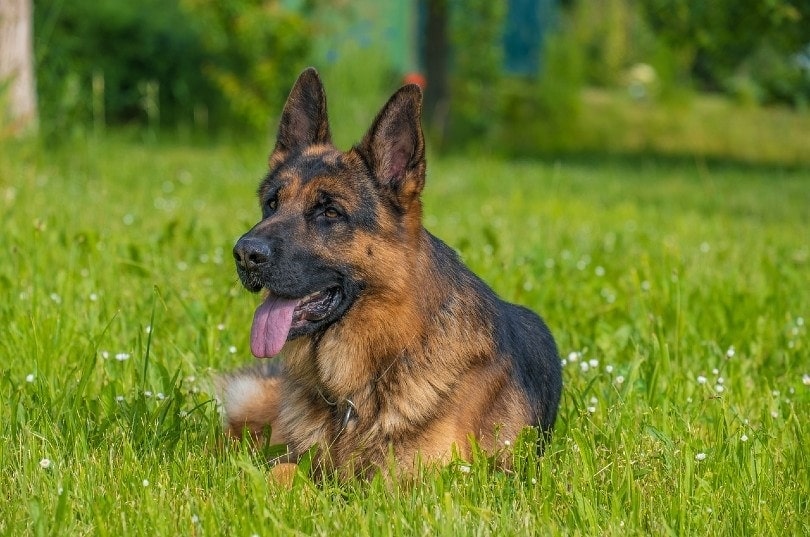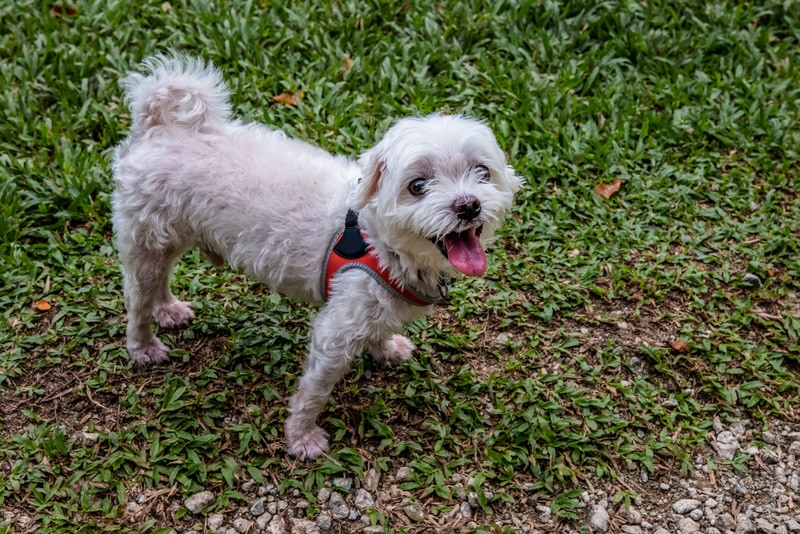Dog Anatomy Basics: 11 Things All Pup Parents Should Know

Updated on
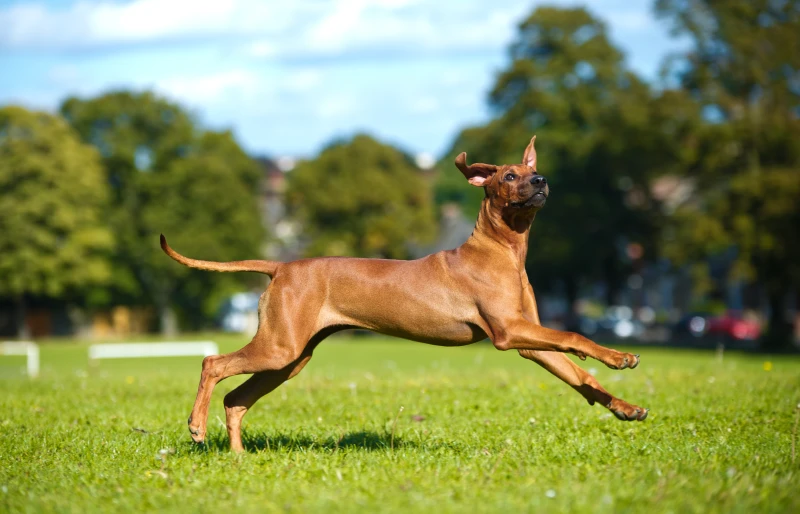
Click to Skip Ahead
Being a responsible and receptive dog owner isn’t always easy. Dogs just aren’t built like us, so having any intuition into health threats can often be next to impossible. Immediate risk factors aren’t always obvious, and unlike people, dogs don’t make a fuss over every injury or discomfort.
Since dogs can have difficulty communicating, it’s up to owners to fill in the gaps. Specific breeds (and dogs in general) are prone to health issues, and by knowing how their bodies work, you can better predict and prepare for potential problems. To help you understand what to watch for in your canine companion, check out these 11 things every pet parent should know about dog anatomy.
The 11 Basics of Dog Anatomy
1. Skull Shape

Breeding over the centuries has led to diverse canine facial features, from the Pug’s squished snout to the Borzoi’s mile-long muzzle. Some shapes were desirable for looks, while others had practical purposes. In companion dogs, the skull shape may only seem significant for appearances, but the implications go much further.
Muzzle Length and Associated Health Problems
The skull can reveal surprising details about a dog. Studies have linked a dog’s head shape to its intelligence 1 and aspects of its behavior 2, giving us clues into how it might operate in a household. More importantly, it can tell us about various health issues a dog may suffer.
The Cephalic Index (CI) measures a dog’s head length relative to its width.
- Dolichocephalic: Long skulls and narrow noses (e.g., Greyhounds, Whippets, Great Danes)
- Mesocephalic: Medium skull length and width (e.g., Beagles, Labrador Retrievers, Chihuahuas)
- Brachycephalic: Broad skull and short snout (e.g., Pugs, Bulldogs, Boston Terriers)
Brachycephaly predisposes dogs to numerous health problems. Brachycephalic Obstructive Airway Syndrome (BOAS) is a collection of signs that create ongoing and sometimes severe respiratory problems. Narrow nostrils and an elongated palate are common issues that cause wheezing, overheating, and general breathing trouble. Corrective surgery is occasionally necessary to preserve the dog’s quality of life.
2. Teeth
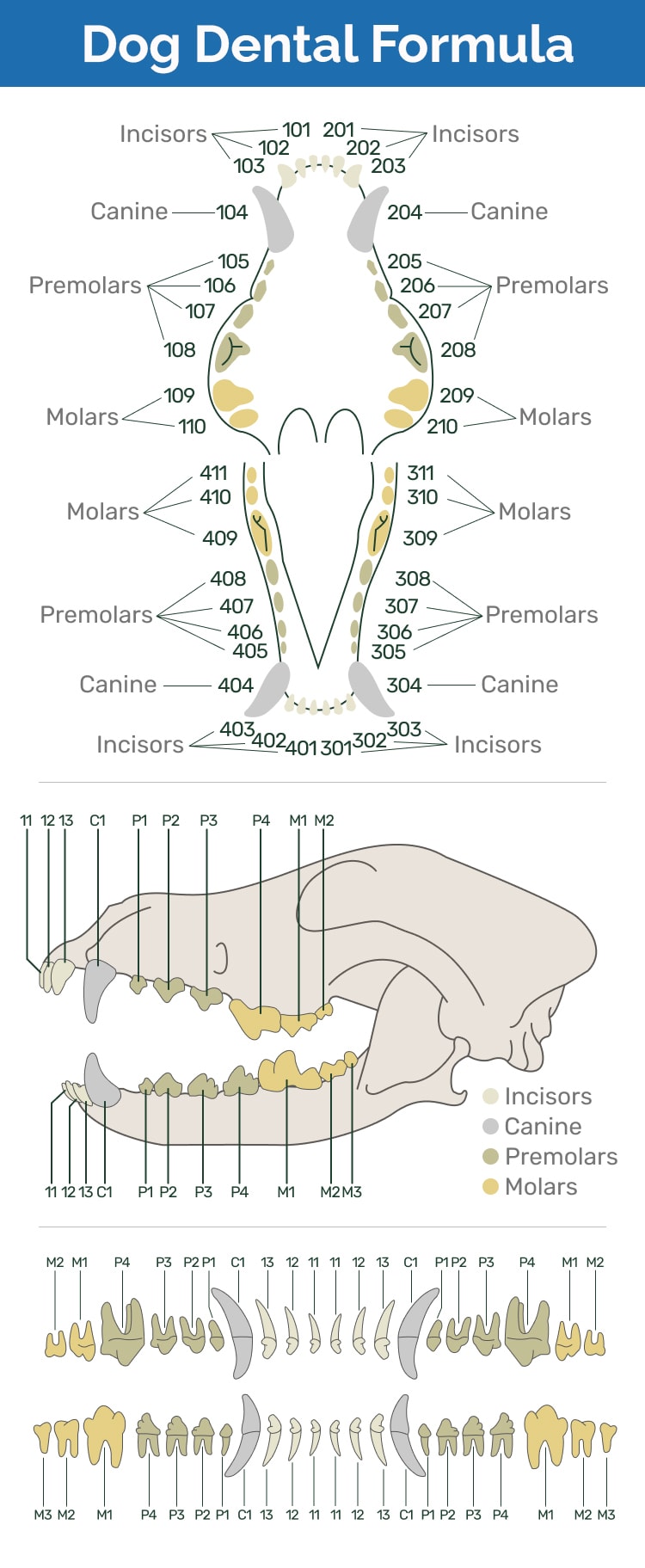
Dogs have 42 permanent teeth. To make way for their final set, puppies lose their 28 baby teeth (or deciduous teeth) after about 3–6 months. Most dogs swallow them as they fall out, a natural habit that won’t typically cause any issues.
Unless a dog retains them, baby teeth rarely create problems. When they grow their adult set, periodontal disease becomes a concern. At least four of every five dogs 3 over three years of age develop the disease. As teeth and gums fall victim to plaque, infections, and inflammation, several symptoms can appear, including:
- Halitosis (bad breath)
- Irritability
- Weight loss
- Loss of appetite
- Excessive drooling
- Tooth loss
Dogs can also develop life-threatening heart conditions if bacteria from tooth infections migrate there. Many small breeds and brachycephalic dogs are more susceptible to developing tooth and gum disease. Without proper daily brushing, vet checkups, and frequent monitoring, any dog can suffer chronic pain and worsening issues associated with poor dental health.
3. Eyes
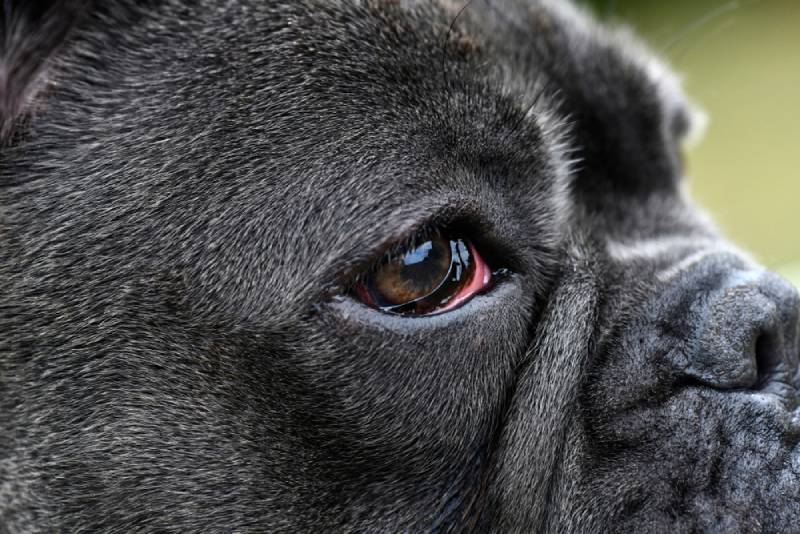
Humans may have better general eyesight than dogs, but there’s still much to say about our canine companions’ visual acuity. They can see better in low light, have extra eyelids for protection, and boast 250-degree peripheral vision. Dog eyes are uniquely complex and highly variable from one breed to the next.
Unfortunately, that also means there is plenty that can go wrong.
- Cherry eye (displaced third eyelid)
- Glaucoma
- Pinkeye
- Cataracts
Certain dog breeds are more prone to eye issues. For instance, brachycephalic dogs, such as Pugs, are likely to have bulging eyes that can sometimes pop out or suffer corneal ulcerations due to exposure. Other dogs inherit conditions from their parents, such as progressive retinal atrophy, an incurable affliction that causes blindness.
4. Ears
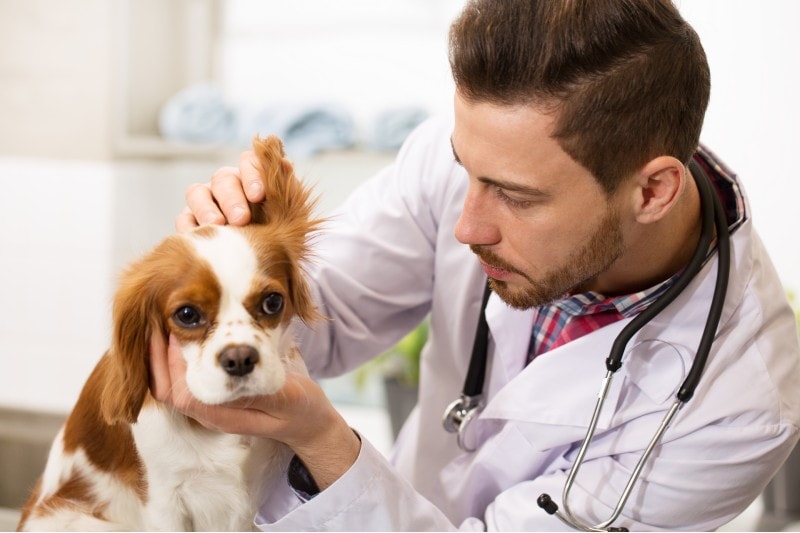
About one in five dogs 4 develop an ear disease of some kind. Issues can arise from various stimuli, including allergies, endocrine problems, or simple moisture buildup that allows bacteria to thrive.
Floppy Dog Ears and Ear Infections
Infections are more common in floppy-eared breeds, such as Cocker Spaniels, Basset Hounds, Labradoodles, and Golden Retrievers, as water and wax can accumulate and allow microbes to flourish. Drop-ear dogs that like to swim need ear inspections after splashing around.
Over-cleaning and under-cleaning a dog’s ears can cause infections. The frequency of cleaning is determined by the particular dog’s lifestyle and ear wax production. Make a habit of checking your dog’s ears so you can quickly spot any signs of ear problems, such as an odd odor or discharge. Other signs to watch for include irregular head shaking and ear scratching.
5. Back and Spine
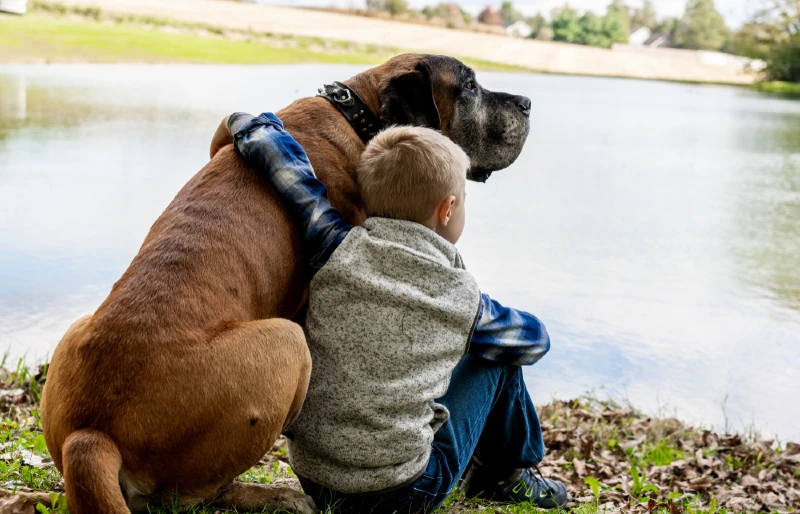
By supporting your pup’s weight and protecting the spinal cord, the vertebral column is an essential part of your dog’s mobility. Keeping it in shape will ensure many fulfilling, active years. Several back diseases can affect your dog, making frequent exercise and a healthy diet a crucial aspect of their lifestyle.
Some dogs have a higher susceptibility to back issues. Dogs with short legs and long backs, like Dachshunds, Corgis, and Basset Hounds, are more likely to develop intervertebral disc disease, a condition involving a herniated disc. Meanwhile, German Shepherds and other medium–large working dogs are more prone to lumbosacral syndrome and experience various issues throughout the lower back and hind end.
Spinal osteoarthritis is a deterioration of cartilage that causes painful inflammation. Wear and tear are the primary culprits, but injury and obesity can hasten its onset. Although arthritis is irreversible, treatments exist to ease the pain and slow the progression of the disease.
6. Tail

Tails are spinal extensions of 6–23 vertebrae that perform several functions for our dogs. Dogs use them to communicate, lifting and wagging them to display happiness and tucking them between the legs to indicate submission. They also help our dogs stay agile, acting as a counterbalance to help them make quicker, more precise movements.
More than any other body part, a dog’s tail is open to fractures, lacerations, and abrasions. Dogs may also overexert their tail muscles, resulting in a strain called limber tail.
Damage is one of the primary reasons for tail docking, which is the painful removal of part of the tail to prevent injuries in working dogs. Today, docking is more of a cosmetic preference. Although there are a few medical reasons to shorten the tail, the practice is generally unnecessary and leaves dogs open to infections.
Happy Tail: Harmful Excessive Tail Wagging
Happy tail syndrome is one reason a dog may need a tail amputation. Issues occur when dogs habitually wag their tail aggressively. They’ll hit it against objects and structures without care, causing bleeding, dryness, and pain. Boarding and crating often encourage happy tail, as the confined quarters make it easy to injure themselves with wagging.
The condition can be frustrating for owners and challenging to treat, making amputation necessary in many instances. Dogs more prone to happy tail are large breeds with strong, narrow tails, such as Greyhounds, German Shepherds, Great Danes, and Labrador Retrievers.
7. Skin
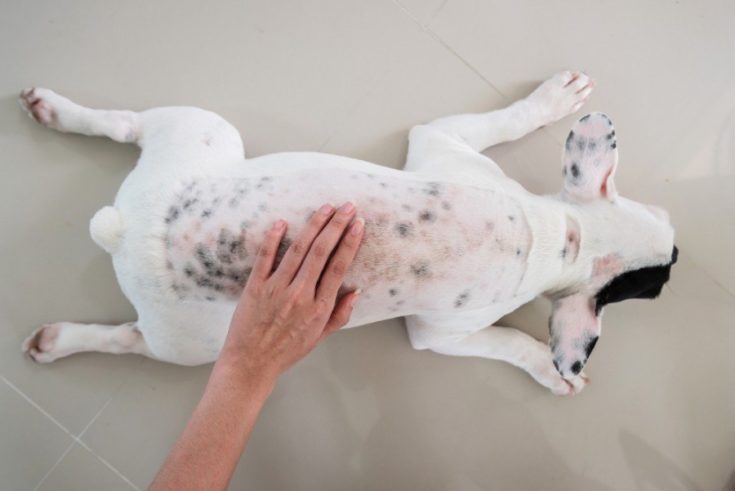
Dogs have sensitive skin under all that fur. Skin allergies are common, occurring from food allergies, bug bites, or environmental allergens.
Atopic dermatitis is a chronic allergic skin condition more prevalent in purebred dogs. Dalmatians, Golden Retrievers, Boxers, and Terriers are a few of the many breeds at a high risk of developing skin allergies.
Allergy flare-ups often occur seasonally, when dust, pollen, and mold spores are at their worst in the spring and summer. Constant scratching is the surest sign of allergies, but studies also show links to behavioral issues. Controlling allergens is crucial in keeping your dog comfortable, while medications and immunotherapy can help them overcome irritation.
Hot Spots
Acute moist dermatitis, also called a hot spot, is localized inflammation that is usually self-inflicted. A dog may scratch or lick an itch, thus opening a small lesion on the skin that invites infection. Although it begins as a tiny red patch, it rapidly worsens, turning to red, oozing, and painful areas the dog will continue to exacerbate through continual licking and scratching.
Allergies, infections, bug bites, stress, and an ungroomed coat can all create the initial irritation that leads to hot spots. Dogs with thicker coats are more likely to develop hot spots, as are pets that enjoy swimming or playing in the water.
8. Joints
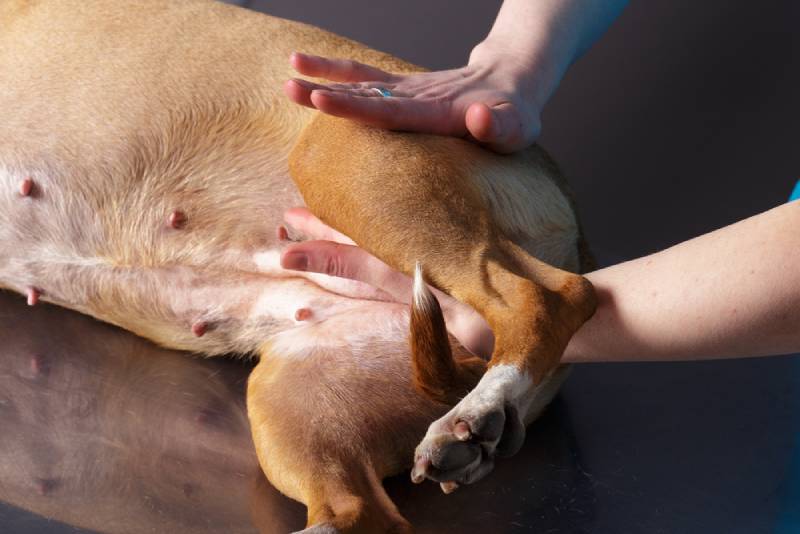
Elbow, knee, and hip problems are some of the most frequent occurrences in aging pets, often stemming from injury or arthritis. Large dogs are often most at risk due to stress on their joints, while genetic defects in some dogs predispose their joints to harm.
- Osteoarthritis
- Elbow dysplasia
- Hip dysplasia
- Luxating patella
Many developmental joint problems appear within the dog’s first year, while others don’t cause signs until the dog matures. Surgery is sometimes necessary, but dysplasia and other ailments often ease with physical therapy, weight management, and conscientious exercise routines.
9. Paws

A dog’s feet consist of five paw pads and four claws, with the front feet having a fifth claw called the dewclaw. Some breeds also have dewclaws on their back feet. The four digital paw pads sit under each toe, with one metacarpal pad in the middle as the “palm.” A carpal pad sits back on the heel, giving the dog extra stopping power while braking fast and maneuvering downhill.
The paws are soft and textured to ease landings and give the dog traction. The dog puts all its weight on its toes, making it critical to protect the precious pads.
Protecting Your Dog’s Paws
Regular nail trimming is crucial in preventing damage to foot and leg joints, while grooming the fur will keep uncomfortable mats from developing between the toes.
Beyond grooming, you must pay attention to where you take your dog. A coarse, rocky hike can damage soft, sensitive pads and wedge painful pebbles between toes, while hot pavement can burn and blister paws.
Stay conscious of where your dog walks when temperatures approach 85°F. Stick to grass and shade on hot days. If you’re an active type that regularly ventures across rough terrain with your dog, you may have to help them develop calluses to toughen up their paws.
10. Sweat Glands
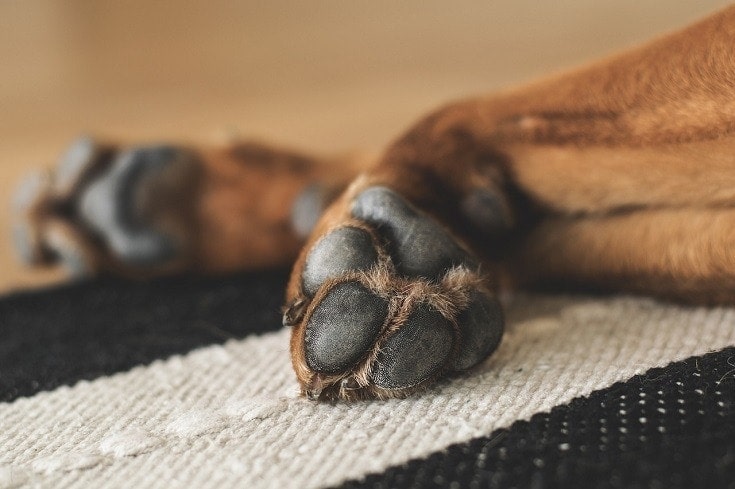
Speaking of dog paws, many people mistakenly believe that the pads under their feet contain the dog’s only sweat glands. In fact, dogs have sweat glands all over their bodies, called apocrine sweat glands. These glands release pheromones but do not help with cooling.
It’s true that dogs can sweat through their paw sweat glands. These glands, called merocrine sweat glands, allow them to release some of their body heat, although this is not a very effective way of cooling off. As sweating plays an enormous role in keeping cool for us, dogs have to make up for that ability in other ways. Beyond sweating through their paws, their only built-in cooling mechanisms are panting and vasodilation, where the blood vessels expand to release heat. Dogs generally can’t tolerate heat like humans, making it crucial to watch for signs of heatstroke.
Signs of Heatstroke in Dogs
Heat stress is dangerous when it goes unnoticed and untreated.
- Heavy, rapid panting
- Excessive drooling
- Bright red gums
- Vomiting
- Tremors or seizures
- Lack of coordination
- Lethargy and faintness
Certain dog breeds, particularly brachycephalic dogs, are more likely to suffer from heatstroke, as are younger and older dogs or those with weight issues. With any dog, staying conscious of the risk and taking immediate action when you spot the signs of heat stress is necessary when you’re out and about.
11. Nails
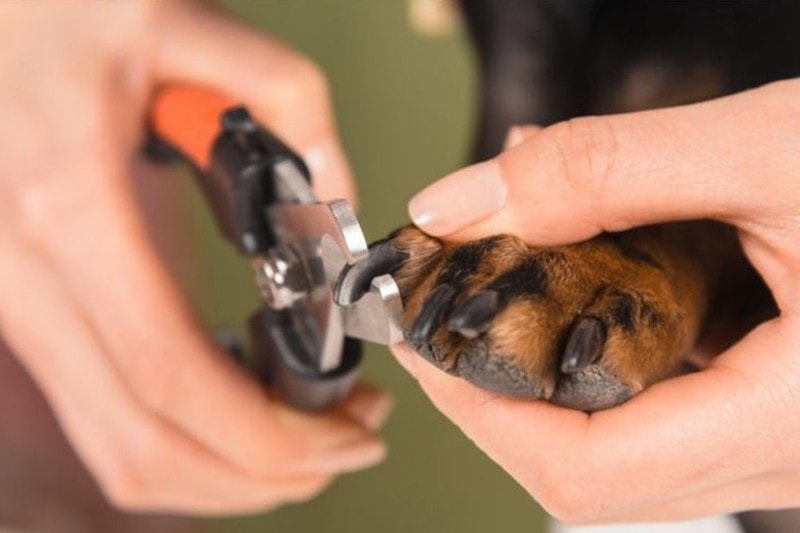
Dogs need regular nail trimmings to stay comfortable and save you from the terror of sharp claws. Untrimmed nails can damage furniture and carpet, and they don’t feel too pleasant against the skin if your dog jumps up on you. For your dog, overgrown nails can lead to discomfort, poor traction, and foot and leg injuries.
Nail Trimming and Locating the Quick
Regular trimming every 1–3 weeks will keep damage to your dog and home to a minimum. But proper trimming is as critical as doing it frequently.
Avoiding the quick is crucial when trimming your dog’s nails. The quick is a blood vessel that flows to the nail’s core. Cutting the nail back too far will sever the quick, causing bleeding and significant pain and leaving the nail open to infection.
Light-colored nails often make the pink quick effortless to spot. Darker nails conceal it well, but shining a flashlight underneath them or locating the groove on the nail’s underside will show you where the quick ends. Regular trimming will shorten the quick, making future grooming faster and easier.
Conclusion
Every aspect of a dog’s lifestyle requires consideration, from the places they walk to the foods they eat. Dogs are hardy animals with plenty of natural traits geared toward survival. But they haven’t entirely adapted to us. Our breeding efforts put several dog breeds at a physical disadvantage, and our urban environments are far different from a canine’s natural surroundings.
As responsible owners, we must make up for the circumstances we force on our dogs. By understanding the basics of your dog’s anatomy and the inherent risks they face, you’ll have an easier time ensuring a long, active, and satisfying life for your four-legged companion.
Featured Image Credit: Tatiana Katsai, Shutterstock




